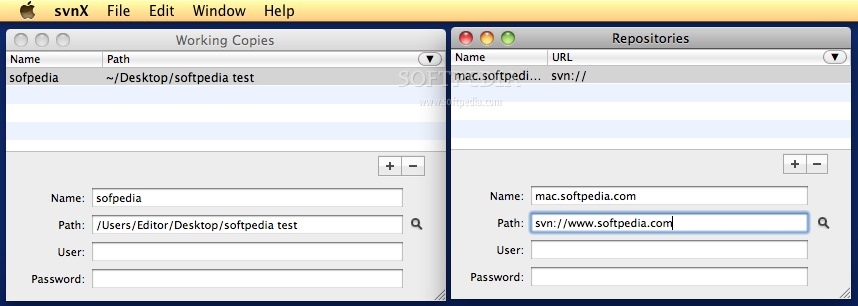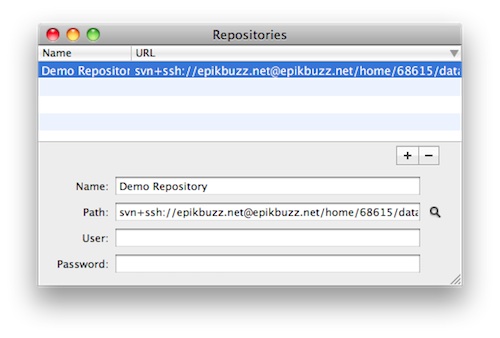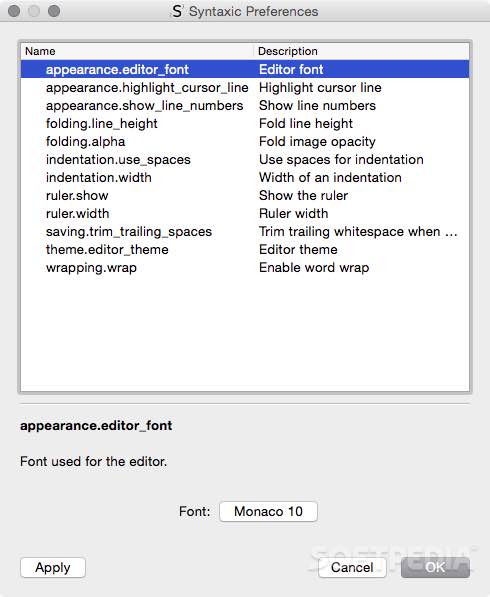2010-10-15 12:23:00. You've got a few free options available to you: SmartSVN - a cross-platform solution that will work on Windows, Mac and Linux. Pysvn - another cross-platform client, free of course. SCPlugin - Mac-only, integrates into Finder. SCPlugin was inspired by TortoiseSVN, so if you're a fan of that one then maybe give it a go! SvnX for Mac Free Download - GUI for Subversion, a replacement for CVS. All groups and messages.


Trusted Mac download svnX 2.0.016960. Virus-free and 100% clean download. Get svnX alternative downloads.
Mac users can be interested in older versions of OS X Yosemite for various reasons. For example, one individual might prefer an older version of OS X Yosemite over the latest update. In contrast, another individual might be using a piece of software that doesn't work right on newer versions.
- OS X 10.10, aka Yosemite, sports a more modern look and bridges the gap between Apple's desktop and mobile devices. The new Continuity helps you hand off tasks from iPhone to iPad to Mac, but that.
- Now macOS X Yosemite is the 11th major release of Apple. And macOS X Yosemite is the best developers for Mac users. Therefore, macOS X Yosemite was announced in 2014 at WWDC and released the beta tester for the public. Still, macOS X Yosemite is one of the best-operating systems among the macOS.
- Install Mac OS X Yosemite on VMware, and it is the 11th major release of Mac, Apple company. Therefore, this version of Mac OS X Yosemite is 10.10 and it was the old version of macOS operating system among the other operating systems.
If OS X Yosemite came preinstalled on your new Mac, you’ll probably never need this article. In this article, you discover all you need to know to install or reinstall OS X, if you should have to.
If you’re thinking about reinstalling because something has gone wrong with your Mac, know that an OS X reinstallation should be your last resort. If nothing else fixes your Mac, reinstalling OS X could well be your final option before invasive surgery (that is, trundling your Mac to a repair shop).
You don’t want to reinstall OS X if something easier can correct the problem. So if you have to do a reinstallation, realize that this is more or less your last hope (this side of the dreaded screwdriver, anyway).
Reinstalling is a hassle because although you won’t lose the contents of your Home folder, applications you’ve installed, or the stuff in your Documents folder (unless something goes horribly wrong or you have to reformat your hard drive), you might lose the settings for some System Preferences, which means you’ll have to manually reconfigure those panes after you reinstall. And you might have to reinstall drivers for third-party hardware such as mice, keyboards, printers, tablets, and the like. Finally, you might have to reregister or reinstall some of your software.
Svnx Download
It’s not the end of the world, but it’s almost always inconvenient. That said, reinstalling OS X almost always corrects all but the most horrifying and malignant of problems. The process in Yosemite is (compared with root-canal work, income taxes, or previous versions of OS X) relatively painless.

How to install (or reinstall) OS X
In theory, you should have to install Yosemite only once, or never if your Mac came with Yosemite preinstalled. And in a perfect world, that would be the case. But you might find occasion to install, reinstall, or use it to upgrade, such as
If your Mac is currently running any version of OS X except Yosemite
If you have a catastrophic hard-drive crash that requires you to initialize (format) or replace your boot drive
If you buy an external hard drive and want it to be capable of being your Mac’s startup disk (that is, a bootable disk)
If you replace your internal hard drive with a larger, faster, or solid state drive
If any essential OS X files become damaged or corrupted or are deleted or renamed
Svnx For Mac Yosemite 2017
The following instructions do triple duty: Of course they’re what you do to install OS X for the first time on a Mac or a freshly formatted hard or solid-state disk. But they’re also what you do if something really bad happens to the copy of OS X that you boot your Mac from, or if the version of OS X on your Mac is earlier than 10.10 Yosemite. In other words, these instructions describe the process for installing, reinstalling, or upgrading OS X Yosemite.
If you’ve never had Yosemite on this Mac, the first thing to do is visit the Mac App Store, download Yosemite, and install it. Once you’ve done that, here’s how to install, reinstall, or upgrade Yosemite, step by step:
Boot from your Recovery HD partition by restarting your Mac while holding down the Command+R keys.
The OS X Utilities window appears. Select Reinstall OS X, and click Continue. The OS X Yosemite splash screen appears. Click Continue.
A sheet appears informing you that your computer’s eligibility needs to be verified by Apple. Click Continue to begin the process of installing or reinstalling OS X.
If you’re not connected to the Internet, you’ll be asked to choose a Wi-Fi network from the AirPort menu in the top-right corner.
The Yosemite software license agreement screen appears. Read it and click Agree.
A sheet drops down, asking whether you agree to the terms of the license agreement. Yes, you did just click Agree; this time you’re being asked to confirm that you indeed clicked the Agree button.
If you don’t click Agree, you can’t go any farther.
Choose the disk on which you want to reinstall OS X by clicking its icon once in the pane where you select a disk.
If only one suitable disk is available, you won’t have to choose; it will be selected for you automatically.
Click the Install button.
A sheet asks for your Apple ID and password. Type them in the appropriate fields; click Sign In, and your Yosemite installation (or reinstallation) begins.
The operating system takes 30 to 60 minutes to install, so now might be a good time to take a coffee break. When the install is finished, your Mac restarts itself.
If you were reinstalling Yosemite on the hard disk that it was originally installed on, or upgrading from Mavericks, you’re done now. Your Mac will reboot, and in a few moments you can begin using your new, freshly installed (and ideally trouble-free) copy of OS X Yosemite.
If, on the other hand, you’re installing Yosemite on a hard disk for the first time, you still have one last step to complete. After your Mac reboots, the Setup Assistant window appears. You need to work your way through the Setup Assistant’s screens as described below.
Svnx 2.0
Getting set up with the Setup Assistant
Download Svnx For Mac Pro
Mac Yosemite Version Number
Assuming that your installation process goes well and your Mac restarts itself, the next thing you should see (and hear) is a short, colorful movie that ends by transforming into the first Setup Assistant screen (Apple Assistants such as this are like wizards in Windows, only smarter), fetchingly named Welcome.
To tiptoe through the Setup Assistant, follow these steps:
When the Welcome screen appears, choose your country from the list by clicking it once, and then click the Continue button.
If your country doesn’t appear in the list, select the Show All check box, which causes a bunch of additional countries to appear.
After you click Continue, the Select Your Keyboard screen appears.
Choose a keyboard layout from the list by clicking it once; then click Continue.
If you want to use a U.S. keyboard setup, click the U.S. listing. If you prefer a different country’s keyboard layout, select the Show All check box, and a bunch of additional countries’ keyboards (as well as a pair of Dvorak keyboard layouts) appear in the list. Choose the one you prefer by clicking it — and then click Continue.
The Select Your Wi-Fi Network screen appears.
Click the name of the wireless network you use to connect to the Internet, type in its password, and then click Continue.
If you don’t see the network you want to use, click Rescan. If you don’t use a wireless network, click Other Network Setup, and then choose one of the available options, or choose My Computer Does Not Connect to the Internet. /cant-see-reply-forward-icons-in-outlook-2016-for-macos/. Click Continue.
The Migration Assistant (also known as the Transfer Information to This Mac) screen appears.
Choose to transfer data, then click Continue, or choose not to transfer data, then click Continue.
If this is a brand-new Mac or you’re installing OS X Yosemite on a Mac and have another Mac or Time Machine backup disk nearby, you can transfer all of your important files and settings by following the onscreen instructions and connecting the new and old Macs via FireWire or Ethernet cable.
Transferring data can take hours — that’s the bad news.
The good news is that once the data transfer finishes, you’re finished, too. In other words, you can ignore the steps that follow (which are only for brand new installations with no data to transfer).
Goodbye and good luck.
Assuming you chose not to transfer data, the Sign In With Your Apple ID screen appears.
If you want to use your Apple ID with this Mac, type it (such as [email protected]) and your password in the appropriate fields, and then click Continue. Or, if you don’t have an Apple ID or prefer not to use one with this Mac, click Don’t Sign In, and then click Continue.
To learn more about getting an Apple ID, click the blue “Learn More” link. In a nutshell, it lets you make one-click purchases at the iTunes Store, iPhoto, or the Apple Store, and includes free iCloud membership.
The Allow iCloud to Use the Location of This Mac for Find My Mac sheet appears.
Click Allow or Not Now.
The Terms and Conditions screen appears.
Read the Terms and Conditions and click Agree. A dialog confirms your agreement. Click Agree again.
The Create A Computer Account screen appears.
Fill in the Full Name, Account Name (sometimes called Short Name), Password, Verify Password, and Hint fields, and then click Continue. Or, check the Use my iCloud Account to Log In checkbox. Then fill in the Account Name (sometimes called Short Name), and click Continue.
This first account that you create will automatically have administrator privileges for this Mac. You can’t easily delete or change the name you choose for this account, so think it through before you click Continue.
You can’t click the Continue button until you’ve filled in the first two fields. Because a password is optional, you can choose to leave both password fields blank if you like. If you do, your Mac warns you that without a password, your Mac won’t be secure. If that’s okay, click OK. If you change your mind and want to have a password, click Cancel.
Click on the little picture to the right of your name (it’s labeled “edit”) if you want to choose a different picture or take a picture of yourself with your Mac’s built-in camera.
If you choose to take a picture, click the Take Photo Snapshot button. When the picture appears, you can change its size by using the slider control directly below the image and/or move it around in the frame by clicking your face and dragging. If you’re not happy with this snapshot, click Retake a Video Snapshot. When you’re happy with it, click Continue.
If you choose to select a picture from the Picture library, click the picture you want to represent you — the butterfly, dog, parrot, flower, or whatever — and then click Continue.
The iCloud Keychain screen appears.
Click Set Up iCloud Keychain or Set Up Later.
If you choose Set Up iCloud Keychain, a screen requesting your passcode appears. Type your four digit passcode, and click Continue.
If you’ve forgotten your passcode or don’t have one, click Forgot Code to reset iCloud Keychain.
In either case, a verification code is sent to your iPhone or other Apple device; type it in, and click Continue.
The OS X Finder’s Desktop appears.
And that’s all there is to it. You’re done.
GUI for Subversion, a replacement for CVS.
Download Svn Client For Mac
Programming Software for Mac PlistEdit ProFree to try. Free download traktor pro 2 for mac. Advanced property list & preference editor. ExtendScript ToolkitFree. GUI wrapper for Subversion, a CVS replacement. Publisher: SvnX Downloads: 10,452 MySQL Query BrowserFree. Publisher: MySQL Downloads: 18,756 CODECFree. Download SvnX for Mac to gUI wrapper for Subversion, a CVS replacement. Download svnx 2.0 for free. Developer Tools downloads – svnX by La Chose Interactive and many more programs are available for instant and free download.
It allows you to browse your working copies, Spot changes and operate on them but also to browse logs and revisions of your repositories.
It”s written using Panther”s new bindings mechanism for maximum flexibility and user experience.
SvnX is brought to you by La Chose Interactive.
Svnx Download
Svnx Download Mac Os
Download Svnx For Mac Os
